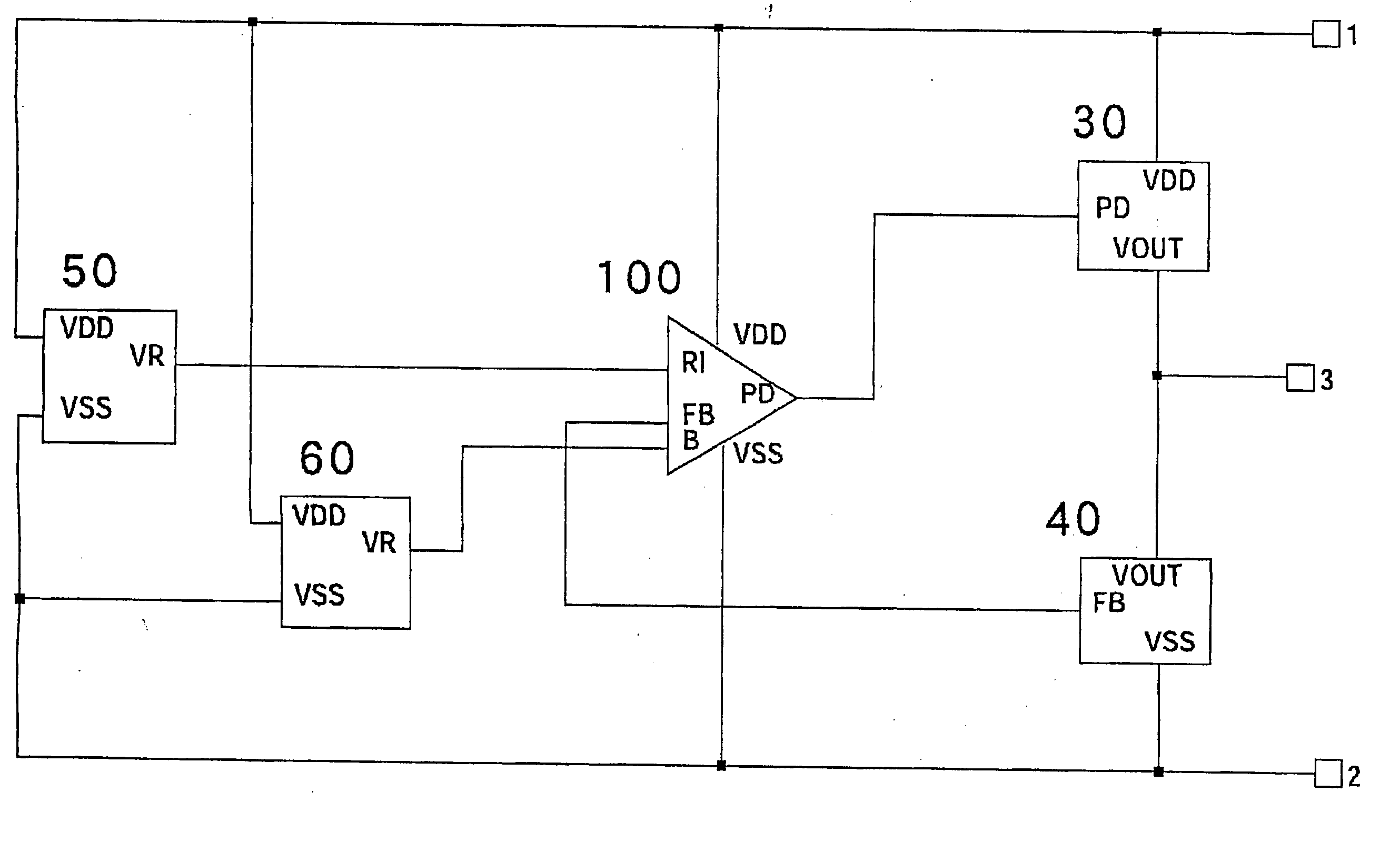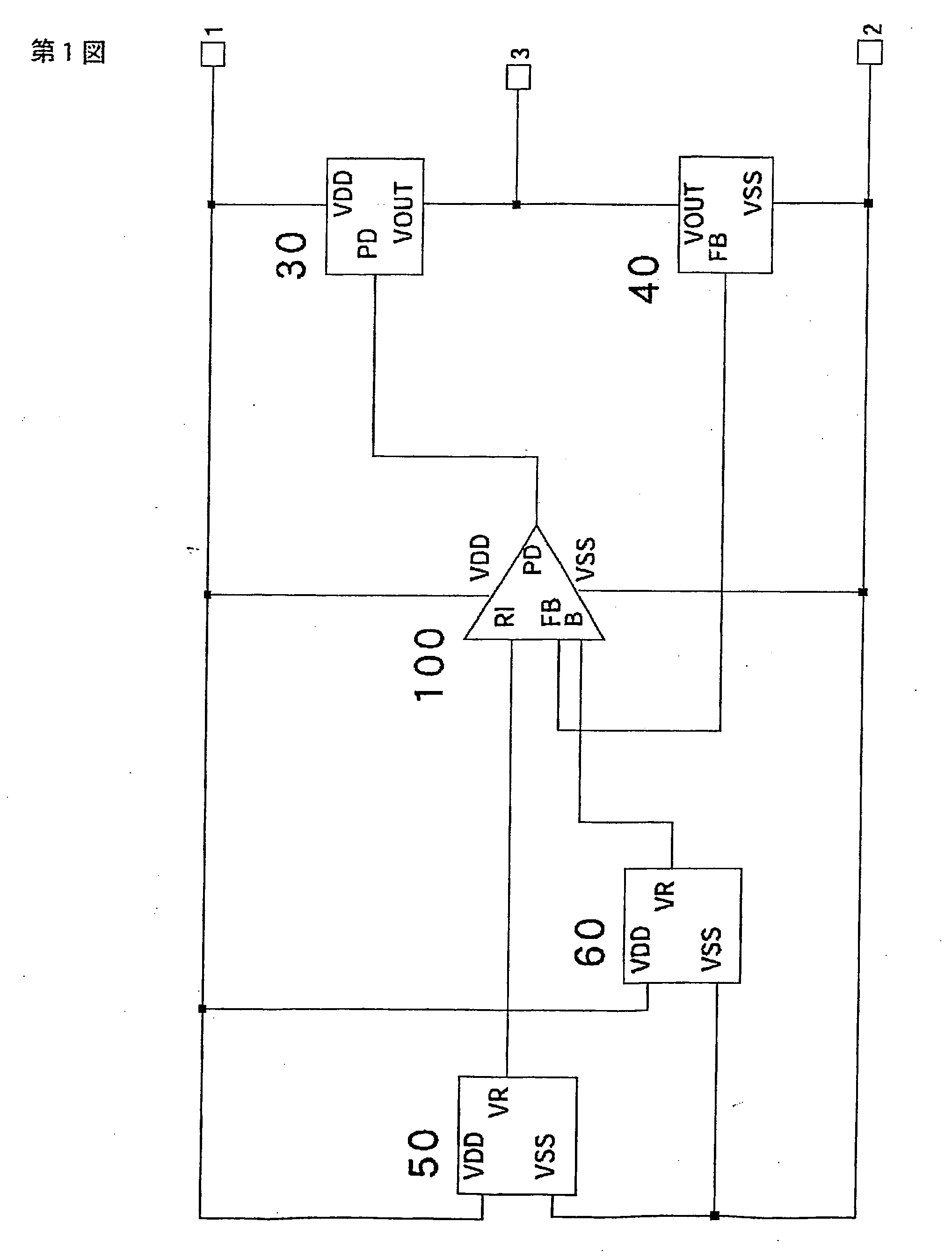Noise filter circuit
- Summary
- Abstract
- Description
- Claims
- Application Information
AI Technical Summary
Benefits of technology
Problems solved by technology
Method used
Image
Examples
first embodiment
(First Embodiment)
[0064]FIG. 18 is a block diagram showing a first embodiment, and FIG. 7 shows a concrete circuit configuration thereof. In line with the circuit configuration in FIG. 2, stated as prior art, in FIG. 7 the error amplifier 100 is a two-stage amplifier; a differential amplifier 10 as a first stage and a phase inverting amplifier 20 as a second stage. The numerals 30, 40, 50 and 60 indicate an output buffer, an error detection voltage-dividing circuit, a reference voltage circuit and a bias current generation circuit, respectively. The difference from the prior art lies in an additional canceling signal generation circuit 80 connected to the input terminal N2.
[0065] The canceling signal generation circuit 80 generates a very finely divided and advanced-phase signal from a noise signal generated in a power source line, and feeds it to the input of the error amplifier circuit, to reject the ripple noise in the high frequency band. FIG. 8 is a variation of the embodiment...
second embodiment
(Second Embodiment)
[0075] Next, the second embodiment of the present invention will be explained by referring to the block diagram of FIG. 19 and the circuit diagram of FIG. 15. The same constituent elements as those in FIG. 7 are indicated with the same numerals.
[0076] In FIG. 15, in comparison with the first embodiment shown in FIG. 7, the canceling transistor array 70, (N5, N6 and N7) is added. The gate of the canceling transistor array 70 is connected to the power source, and the ripple noise signal on the power source line is directly added.
[0077] The cascade transistors like N5 and N6, included in the canceling transistor array 70, are mentioned in the reference U.S. Pat. No. 4,533,877 that shows the improvement of the PSRR. Another reference U.S. Pat. No. 5,113,148 also exemplifies the cascaded transistors. The gate terminal of all the conventional cascaded transistors is connected to a dedicated reference voltage for matching the current values. Otherwise, a current mismat...
third embodiment
(Third Embodiment)
[0081] A block diagram in FIG. 20 shows a third embodiment of the present invention. The circuit shown in FIG. 16 is its concrete circuit configuration. The same components as those in FIG. 7 are designated by the same symbols. In the present embodiment, both of the canceling signal generation circuit 80 and the canceling transistor array 70 are implemented.
[0082] As a variation of the above-mentioned embodiment, a circuit diagram is shown in FIG. 17. In this circuit configuration, the bias current generation circuit 60 is omitted and the reference voltage generation circuit 50 can also serve as the bias current generation circuit.
(Inclination of System Offset—1)
[0083]FIG. 9 is a graph showing the simulation of the dependency characteristics of each circuit section when the power voltage Vdd changes in the embodiment shown in FIG. 15. The curves 94 and 91 indicate the drain current and the output voltage Vout of P3, respectively in case of absence of the cancel...
PUM
 Login to View More
Login to View More Abstract
Description
Claims
Application Information
 Login to View More
Login to View More - R&D
- Intellectual Property
- Life Sciences
- Materials
- Tech Scout
- Unparalleled Data Quality
- Higher Quality Content
- 60% Fewer Hallucinations
Browse by: Latest US Patents, China's latest patents, Technical Efficacy Thesaurus, Application Domain, Technology Topic, Popular Technical Reports.
© 2025 PatSnap. All rights reserved.Legal|Privacy policy|Modern Slavery Act Transparency Statement|Sitemap|About US| Contact US: help@patsnap.com



